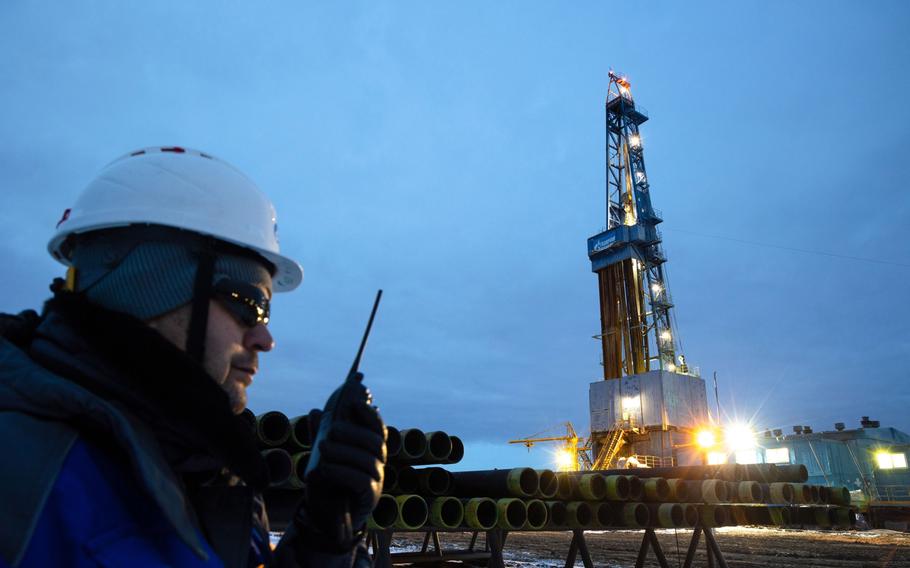Europe
AnalysisHere's where Russian oil flows
The Washington Post March 9, 2022

Lights illuminate a gas drilling rig on the Gazprom Chayandinskoye oil, gas and condensate field, a resource base for the Power of Siberia gas pipeline, in the Lensk district of the Sakha Republic, Russia, on Oct. 13, 2021. (Andrey Rudakov/Bloomberg)
The shock of Russia's invasion of Ukraine has upended politics around the world and posed a key question: Should the rest of the world shun Russian oil to avoid paying money to the Putin regime?
The Biden administration has decided to ban the import of oil and natural gas from Russia, expanding on the sweeping economic sanctions already in place. The European Union, which relies much more heavily on imports of Russian oil, has not yet taken action, though it has vowed to cut its use of Russian gas by two-thirds this year.
Russia is the world's largest oil exporter. Many lawmakers from both parties in the United States are arguing that it is possible to impose a ban on Russian oil without hurting the U.S. economy. But will the barrels add up in the global market? Oil analysts say the sheer magnitude of Russia's oil exports makes them difficult if not impossible to offset, setting up high prices and an economic slowdown.
Here is a look at the flow of Russian oil, from western Siberia or the distant Yamal Peninsula to the cities of Beijing, Berlin and beyond.
Who can produce enough oil to make up for the loss of Russia's?
This is a daunting task, especially since global demand for oil is expected to climb 3.2 million barrels a day in 2022 to a total of 100.6 million a day, according to the International Energy Agency's most recent monthly report.
In addition, current exports could be disrupted if internal fighting were to break out, as it has before, in places such as Libya, Iraq or Nigeria. And some refineries can only be matched with certain grades of crude.
"This is suboptimal math for the White House," said Helima Croft, head of global commodity strategy at RBC Capital Markets. "You have to string it together, and everything has to break your way."
Saudi Arabia and the United Arab Emirates
These two countries control about 2 million to 2.5 million barrels a day or more of spare capacity but are restraining output to keep prices high and to keep a cushion for even greater crises.
Most of that spare capacity rests in the hands of the Saudi kingdom, often known as the central bank of oil. The IEA already expects the UAE to raise output by 400,000 barrels a day. Iraq and Kuwait could increase output slightly.
All four countries are members of the 62-year-old Organization of the Petroleum Exporting Countries, which started meeting with non-OPEC countries about five years ago to more effectively curtail supply and boost prices. The combined group — which is known as OPEC+ and includes Russia — met recently and did not change production quotas. So far, the Saudi-Russia alliance appears to be working, despite President Joe Biden's entreaties that the kingdom put more oil onto world markets.
Iran
If negotiations over Iran's effort to develop nuclear weapons succeed, and if trade sanctions are then lifted, Iran could boost its crude oil exports by as much as 1.3 million barrels a day.
But the negotiations have been arduous and have been complicated by the fact that Russia must sign off on any accord with Iran. Last week, Russia presented a new condition: a U.S. guarantee that the sanctions that have been imposed on Moscow for invading Ukraine will not be applied to Russian trade and investment with Iran. Even without this condition, Iran is supposed to open its facilities to verification before sanctions are lifted.
Venezuela
Though it is one of the five founding members of OPEC, Venezuela has suffered from poor management and tough U.S. sanctions. It does not have the ability to switch on oil output overnight like Saudi Arabia, but Biden administration officials have started reaching out to its leaders amid the crisis. Its wells need extensive maintenance, but with Western assistance and capital investment Venezuela could squeeze out as much as half a million to 600,000 barrels a day within a few months or a year.
But tensions remain between the United States and Venezuela, which has been run by populist dictators. The goals of the U.S. sanctions have not been met. Moreover, the Venezuelan oil fields pose some of the world's gravest environmental concerns.
United States
The United States might also be a source of new streams of oil; the Energy Information Administration forecasts a 760,000-barrel-a-day increase in U.S. production in 2022, bringing it to 12 million barrels a day. Some industry executives say the increase could be as much as 1 million barrels a day, mostly from shale oil. This increase would take weeks or months.
Where can Russia turn if more countries impose sanctions on its oil?
Russia could lose some market share if other countries step in. But prices are high even after traders insist on $25-to-$30 discounts on Russia's oil.
The Kremlin can look to China, a growing customer. Or it can look to India, which imports nearly 85% of its 4.3 million-barrel-a-day crude requirements but gets less than 3% of that from Russia, according to S&P Global Commodity Insights' Platts Analytics.
Import and export numbers for crude oil and related products come from Trade Data Monitor and generally cover 12 months ending in October 2021. Data for countries' future production potential comes from the IEA, the U.S. Energy Information Administration, Rapidan Energy Group and RBC Capital Markets.